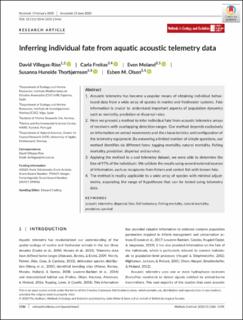| dc.contributor.author | Villegas-Ríos, David | |
| dc.contributor.author | Freitas, Carla | |
| dc.contributor.author | Moland, Even | |
| dc.contributor.author | Thorbjørnsen, Susanna Huneide | |
| dc.contributor.author | Olsen, Esben M. | |
| dc.date.accessioned | 2020-11-06T14:41:56Z | |
| dc.date.available | 2020-11-06T14:41:56Z | |
| dc.date.created | 2020-10-09T11:08:08Z | |
| dc.date.issued | 2020 | |
| dc.identifier.citation | Methods in Ecology and Evolution. 2020, 11 (10), 1186-1198. | en_US |
| dc.identifier.issn | 2041-210X | |
| dc.identifier.uri | https://hdl.handle.net/11250/2686805 | |
| dc.description.abstract | Acoustic telemetry has become a popular means of obtaining individual behavioural data from a wide array of species in marine and freshwater systems. Fate information is crucial to understand important aspects of population dynamics such as mortality, predation or dispersal rates.
Here we present a method to infer individual fate from acoustic telemetry arrays of receivers with overlapping detection ranges. Our method depends exclusively on information on animal movements and the characteristics and configuration of the telemetry equipment. By answering a limited number of simple questions, our method identifies six different fates: tagging mortality, natural mortality, fishing mortality, predation, dispersal and survival.
Applying the method to a cod telemetry dataset, we were able to determine the fate of 97% of the individuals. We validate the results using several external sources of information, such as recaptures from fishers and control fish with known fate.
The method is readily applicable to a wide array of species with minimal adjustments, expanding the range of hypotheses that can be tested using telemetry data. | en_US |
| dc.language.iso | eng | en_US |
| dc.title | Inferring individual fate from aquatic acoustic telemetry data | en_US |
| dc.type | Peer reviewed | en_US |
| dc.type | Journal article | en_US |
| dc.description.version | publishedVersion | en_US |
| dc.source.pagenumber | 1186-1198 | en_US |
| dc.source.volume | 11 | en_US |
| dc.source.journal | Methods in Ecology and Evolution | en_US |
| dc.source.issue | 10 | en_US |
| dc.identifier.doi | 10.1111/2041-210X.13446 | |
| dc.identifier.cristin | 1838430 | |
| dc.relation.project | Norges forskningsråd: 201917 | en_US |
| dc.relation.project | Norges forskningsråd: 294926 | en_US |
| cristin.ispublished | true | |
| cristin.fulltext | original | |
| cristin.qualitycode | 2 | |
